- Gravitational wave detection with Gaia astrometry
- Tianyu project (天语计划)
- Detect black holes and compact objects and other dark companions using Gaia and other data
- Detect cold Jupiters through combined analyses of RV and Gaia-Hipparcos data
- Highly automatical detection of exoplanets
- Precise exoplanetology
- Develop techniques to detect Earth analogs
- Stability of wide binaries
- Formation and evolution of the Oort cloud in light of Sedna-like objects
- The origins of multiple populations in globular clusters
- Architecture habitability of exoplanets
- Find exocomets in the Solar System
- Find the imprint of culprit stars in long period comets
- Quantum analog of terrestrial climate
- The history of comet impact rate
Gravitational wave detection with Gaia astrometry


Since LIGO/Virgo’s first detection, hundreds of stellar-mass BH mergers have been observed, but supermassive BH binaries (SMBBHs) remain elusive. Pulsar timing arrays (PTAs) recently reported ∼4σ evidence for a nano-hertz GW background via the Hellings–Downs correlation, with strain ∼10⁻¹⁵. We propose a complementary astrometric search using Gaia: compare DR2 vs. DR3 to detect stellar accelerations induced by SMBBH GWs. With ~10⁸ stars at ~10 μas precision, Gaia could sense ~1 nas deflections—again corresponding to strain ~10⁻¹⁵, comparable to PTA sensitivity. Unlike PTAs, Gaia offers uniform all-sky sampling and sensitivity that remains effective at tens of nHz. This project is funded by China’s National Key R&D Program (MOST) in collaboration with Shanghai Astronomical Observatory and Shenzhen Technology University.
Tianyu project (天语计划)

Tianyu telecope 
Tianyu survey footprint 
Tianyu detection limit 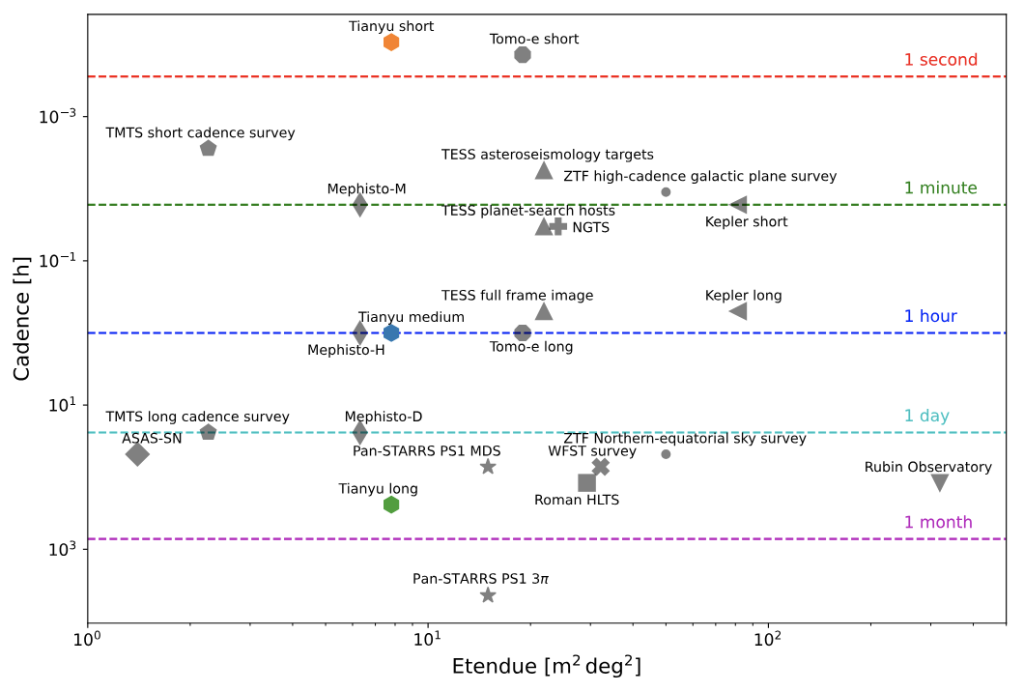
Tianyu compared with other surveys
Detection of Dark Companions by periodogram analyses of Gaia catalog data
Tianyu project is funded by the JiaoDa 2030 B program and the Tianyu telescope will start its scientific observation at the Lenghu Saishiteng Mountain (>4000m altitude) in 2026. It will produce about 3PB raw data per year and will produce real-time alerts and data reduction with a time delay less than 1min. While Tianyu is mainly to detect long period transiting planets, it will also conduct time-domain science.
Relevant publications:
- F. Feng*, Y. Rui*, et al. 2024, Tianyu: search for the second solar system and explore the dynamic universe, accepted by Acta Astronomica Sinica
Detect black holes and compact objects and other dark companions using Gaia and other data
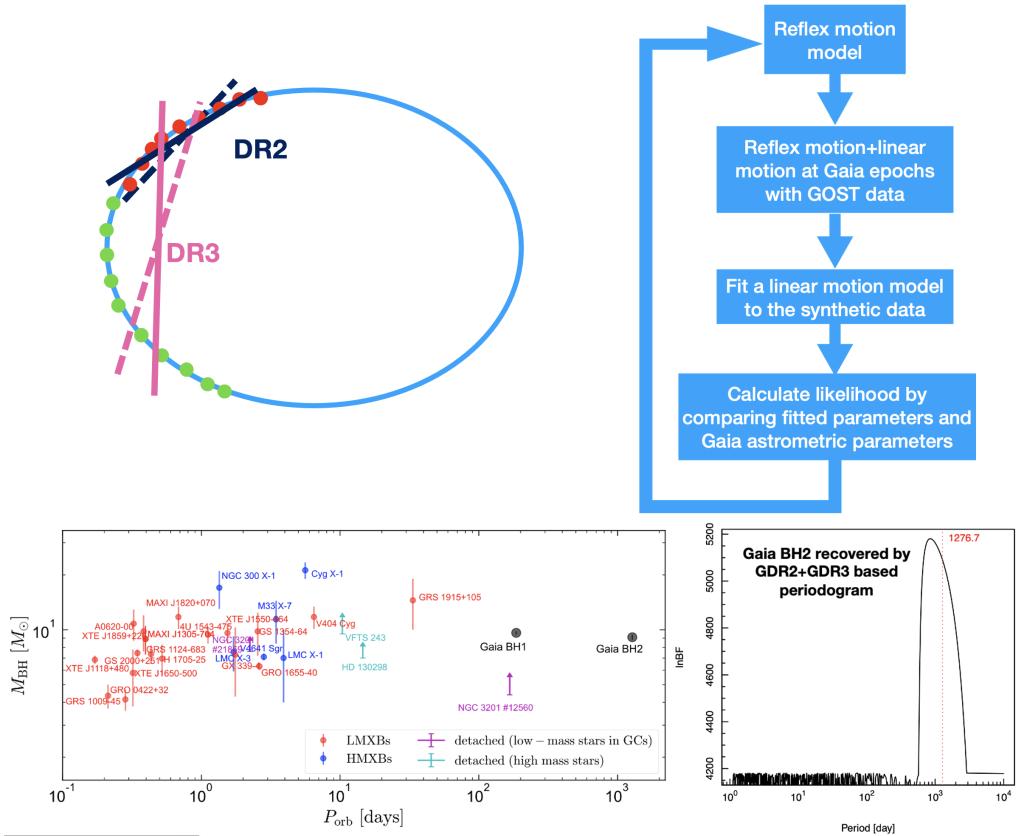
Detection of Dark Companions by periodogram analyses of Gaia catalog data
Although Gaia has released three data releases, it will not released its epoch data (or time series data) until Gaia DR4. To use Gaia DRs to detect dark companions such as black holes, neutron stars, wide dwarfs, exoplanets and other compact objects, we use GOST to simulate the Gaia epoch data and refit the synthetic epoch data using the 5-parameter linear astrometric model. By modeling the Gaia DRs in this way and calculating the chi2 or Bayes Factor for a sample of periods, we calculate the so-called astrometric Bayes Factor Periodogram (ABFP) to find periodic signals in Gaia DRs. As shown in the above figure, we are able to cover the astrometric signal for Gaia BH2, demonstrating the potential of ABFP in finding millions of dark companions and binaries.
Relevant publications:
- F. Feng, Y. Rui, Y. Xuan, H. Jones 2024, Modeling and Calibration of Gaia, Hipparcos, and Tycho-2 Astrometric Data for the Detection of Dark Companions, ApJS, 271(2), p.50.
Detect cold Jupiters through combined analyses of RV and Gaia-Hipparcos data
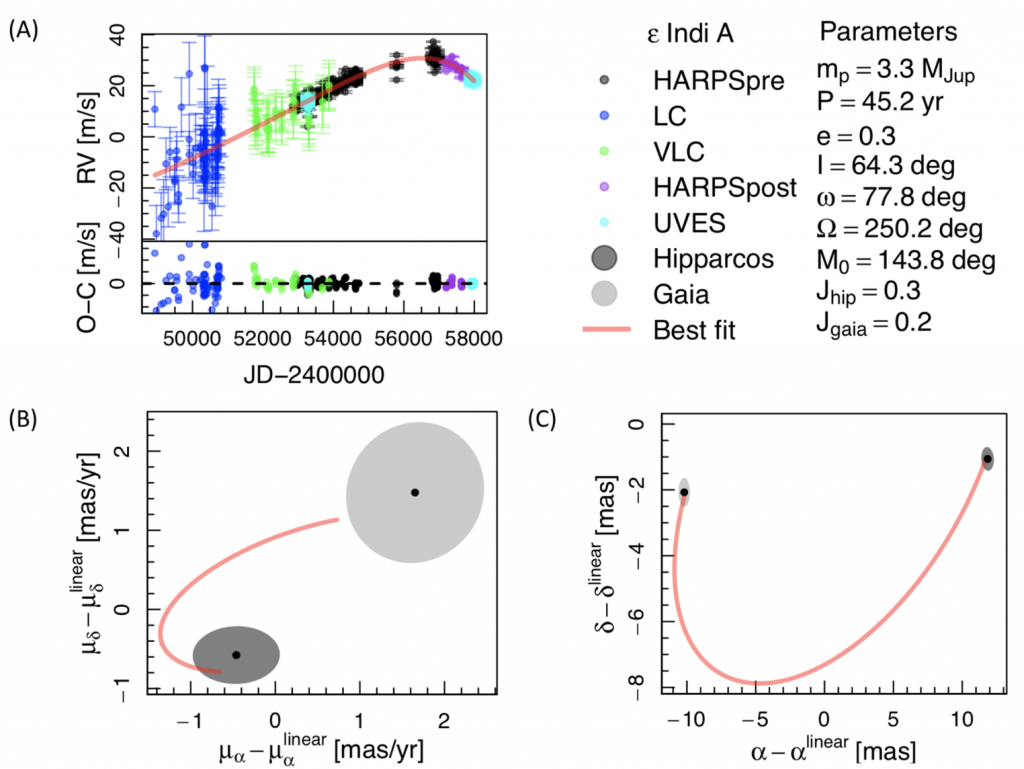
Synergy between RV and Gaia astrometry
Since Gaia and Hipparcos measure precise positions of stars over a 24 year time span, the difference in their positions and proper motions for a given star can be used to constrain the stellar acceleration due to large planets or brown dwarfs. Our modeling of both RV and Gaia-Hipparcos offsets enable us to discover the nearest Jupiter analog, eps Indi A b. This approach will be applied to thousands of nearby stars to find a large sample of cold Jupiters and brown dwarfs.
Relevant publications:
- F. Feng, G. Anglada-Escude, M. Tuomi, H. R. A. Jones, J. Chaname, P. R. Butler, M. Janson 2019, Detection of the nearest Jupiter analog in radial velocity and astrometry data, MNRAS, 490, 5002
- Fabo Feng, R Paul Butler, et al., 2021. Optimized modelling of Gaia–Hipparcos astrometry for the detection of the smallest cold Jupiter and confirmation of seven low-mass companions. MNRAS, Issue 2, pp.2856-2868
- F. Feng, et al. 2023, Revised orbits of the two nearest Jupiters, MNRAS, 525, 607
Highly automatical detection of exoplanets

The automated Agatha includes the following functions.
- Tempered MCMC explore the global maxima of posterior
- Cold chains explore the local maxima and constrain the signals
- Compare models with different number of planet signals in the Bayesian framework
- Diagnose signals using the Bayes factor periodograms (BFPs) for activity indices, different noise models and different instruments to check the signal consistency
- Diagnose signals using the moving periodogram to check consistency over time
RELEVANT PUBLICATIONS:
- Feng, F., Shectman, S.A., Clement, M.S., Vogt, S.S., Tuomi, M., Teske, J.K., Burt, J., Crane, J.D., Holden, B., Wang, S.X. and Thompson, I.B., 2020. Search for Nearby Earth Analogs. III. Detection of 10 New Planets, 3 Planet Candidates, and Confirmation of 3 Planets around 11 Nearby M Dwarfs. The Astrophysical Journal Supplement Series, 250(2), p.29.
- Feng, F., Butler, R.P., Shectman, S.A., Crane, J.D., Vogt, S., Chambers, J., Jones, H.R., Wang, S.X., Teske, J.K., Burt, J. and Diaz, M.R., 2020. Search for Nearby Earth Analogs. II. detection of five new planets, eight planet candidates, and confirmation of three planets around nine nearby M dwarfs. The Astrophysical Journal Supplement Series, 246(1), p.11.
- F. Feng, J. D. Crane, S. X. Wang, J. K. Teske, S. A. Shectman, M. R. Díaz, I. B. Thompson, H. R. A. Jones, R. Paul Butler 2019, Search for Nearby Earth Analogs. I. 15 Planet Candidates Found in PFS Data, ApJS, 242, 2
Precise exoplanetology
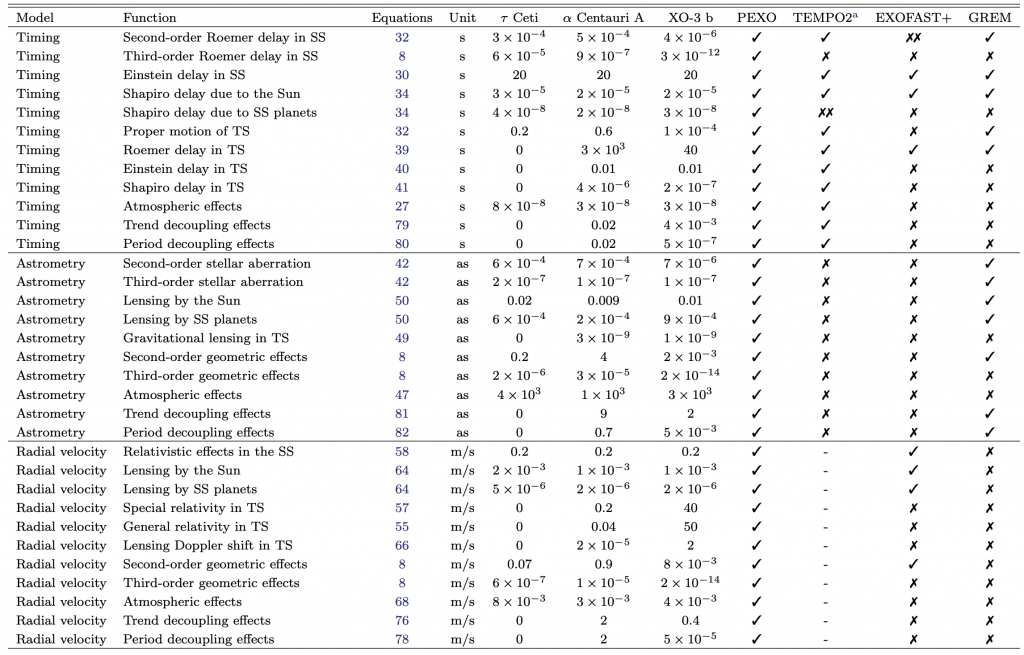
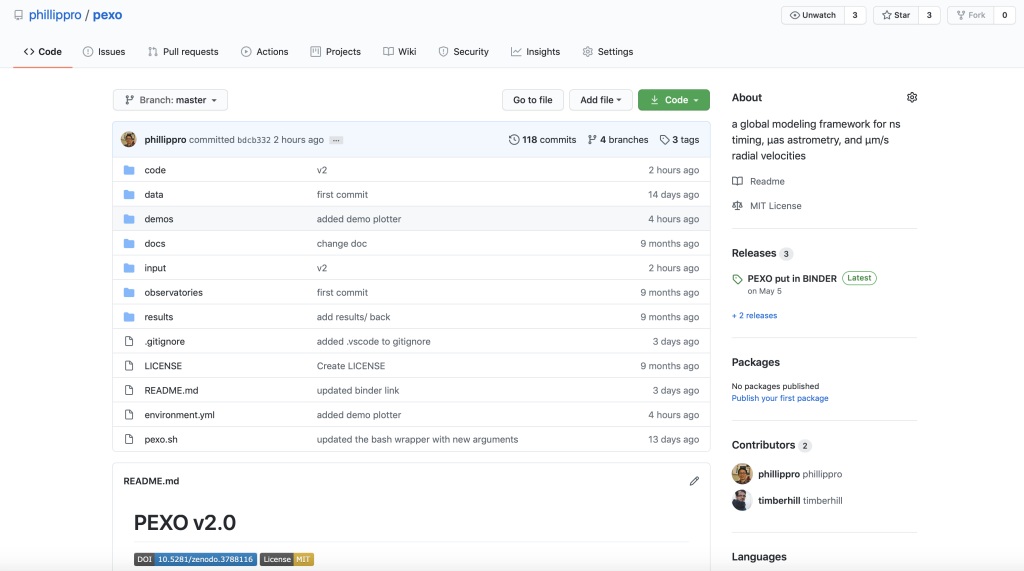
RELEVANT PUBLICATIONS:
- F. Feng, M. Lisogorskyi, H. R. A. Jones, S. M. Kopeikin, R. P. Butler, G. Anglada-Escude, A. P. Boss 2019, PEXO: a global modeling framework for nanosecond timing, microsecond astrometry, and μm/s radial velocities, ApJS, 244, 39
Develop techniques to detect Earth analogs

Goldilocks principle in noise modeling
During postdoctoral research at the University of Hertfordshire, I have applied the Bayesian reference in the analysis of radial velocity data to detect exoplanets. I have introduced the so-called “Goldilocks principle†in the noise modeling of radial velocity data to avoid false positives and false negatives (Feng et al. 2016). According to my research, the moving average model is optimal in modeling correlated noise.
Disentangling periodic signals from correlated noise in the Agatha framework
I have developed the red noise periodograms called Bayes factor periodogram (BFP) and marginalized likelihood periodogram (MLP) based on likelihood optimization and marginal- ization. These periodograms are combined to form a framework, which is implemented in the Agatha web application (http://www.agatha.herts.ac.uk). Agatha has been found to out- perform previous periodograms in terms of removing correlated noise, selecting noise models, and testing consistency of signals (Feng et al. 2017b). It is also one of the data analysis tools for the Red Dots Campaign.
Detection of the weakest signals in radial velocity data
I have also pioneered a new noise proxy called “differential radial velocities†to model the wavelength-dependent noise in the radial velocity data. This proxy is able to weight a posteriori the radial velocity data measured within different wavelength ranges. The application of this proxy and the other statistical methods I have developed in the analysis of the radial velocity data of HD 20794 and τ Ceti leads to detections of a few Earth-size planets corresponding to radial velocity variation as low as 0.3 m/s, the weakest signal ever detected using the radial velocity method (Feng et al. 2017c,d). The work on τ Ceti has been covered by media such as CNN, BBC, Daily Mail, Sky News, Gizmodo, Sky & Telescope, etc.
Relevant publications:
- F. Feng, M. Tuomi, H. R. A. Jones, J. Barnes, G. Anglada-Escude, S. Vogt & R. P. Butler, 2017, Color difference makes a difference: four planet candidates around tau Ceti, AJ, 154, 135
- F. Feng, M. Tuomi & H. R. A. Jones, 2017, Evidence for at least three planet candidates orbiting HD20794, A&A, 605, A103
- F. Feng, M. Tuomi & H. R. A. Jones, 2017, Agatha: Disentangling periodic signal from correlated noise in a periodogram framework, MNRAS, 470, 4794, the corresponding online application is available at http://www.agatha.herts.ac.uk
- F. Feng, M. Tuomi, H. R. A. Jones, R. P. Butler & S. Vogt, 2016, A Goldilocks principle for modeling radial velocity noise, MNRAS, 461, 2440
Stability of wide binaries

Capture scenario of the Proxima-alpha Centauri system
I am currently investigating the influence of stellar encounters on the dynamical evolution of wide binaries. I have found that Proxima was probably captured by alpha Centauri based on simulations of the Proxima’s orbits under the perturbations from the Galactic tide and stellar encounters over ±5 Gyr. This hypothesis is also supported by the metallicity difference between Proxima and alpha Centauri A and B (Feng & Jones 2017b). If the capture scenario is true, Proxima b (Anglada-Escude et al. 2016) is more likely to be in the habitable zone for a long time due to a shorter time scale of the interaction between Proxima b and alpha Centauri. This work has been covered by IFLScience, New Scientist, Gizmodo, etc.
A new classification of wide binaries and multiples
In this paper, I argue that Fomalhaut C is a so-called gravitational pair of Foma-haut A and B. In other words, Fomalhaut C is in a meta-stable state such that it becomes bound and unbound repeatedly with respect to Fomalhaut A and B. Like the Cooper pair mechanism in superconductors, this phenomena only appears once the orbital energy of a com- ponent becomes comparable with the energy fluctuations caused by the environment. Gaia will provide high precision astrometry for millions of stars which provide six dimensional initial conditions of stars with velocity errors less than 1 km/s. Numerical integration of the orbits of these stars along with abundance analyses can enable discoveries of coeval and non-coeval gravitational pairs in bound and unbound states. This project may also provide candidates of gravitational pairs of the solar system and test the Nemesis hypothesis (Whitmire & Jackson 1984).
Relevant publications:
- F. Feng & H. R. A. Jones, 2018, Understanding Fomalhaut as a Cooper pair, MNRAS, 474, 4412
- F. Feng & H. R. A. Jones, 2018, Was Proxima captured by alpha Centauri A and B?, MNRAS, 473, 3185
Formation and evolution of the Oort cloud in light of Sedna-like objects

The orbits of Sedna and 2012 VP112 have generated new interest in the formation and evolution of the Oort Cloud. The perihelia of Sedna and 2012 VP113 are 76 and 81 AU, and their eccentricities are 0.86 and 0.70, respectively. Considering their high eccentricities, they could not form in their current locations, otherwise, they would be disrupted by planetesimals with large relative velocities. Thus they may have migrated to their current eccentric orbits through interactions with one or a few massive objects, which could be an unseen planet or a solar companion beyond the Kuiper belt, a single star, or stars in the open cluster in which the Sun formed. All these scenarios more or less assume the existence of an unseen solar companion or stellar encounters. However, the recent result of WISE survey seems to exclude most of the combinations of the mass and orbital elements of an unseen solar companion. In addition, the stochastic stellar encounters in this scenario may not properly explain the concentration of the arguments of perihelia of Sedna-like objects at omega=0.
Instead of invoking an unknown planet or stellar encounter, I will model the formation of the Sedna-like bodies based on the solar apex motion, which could induce a preferred plane where the tidal force imposed on the Oort cloud is stronger than that far from the plane. This project aims to model the formation of the inner Oort cloud and the extended scattered disc, and test whether the perihelion concentration can be caused by the solar apex motion.
Relevant publication
F. Feng & C.A.L. Bailer-Jones, 2014, Exploring the role of the Sun’s motion in terrestrial comet impacts, MNRAS, 442, 3653
The origins of multiple populations in globular clusters
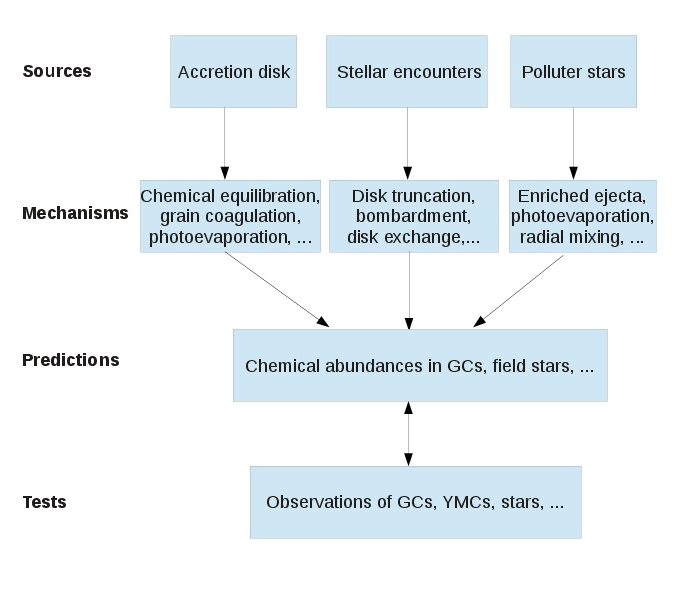
The formation and evolution processes leading to GCs are still poorly understood today, despite the growing body of literature over the last decades. GCs were for long considered single stellar populations. However, studies recently showed characteristics of multiple populations in many of these systems. In specific, GCs present specific chemical abundances of light elements, such as He, Na, O and Al, that we do not find in other kind of clusters (Carretta et al. 2009). To explain these abundances in GCs, many studies converge towards multiple star formation episodes, and they suggested that the secondary generations of stars form out of a mix of pristine gas and ejecta from interacting massive binary stars (de Mink et al. 2009) and other polluter stars (D’Ercole et al. 2010; Denissenkov & Hartwick 2014) present in the previous generations. Nevertheless, multiple star formation episodes are not fully supported by observations of YMCs. For example, the gas and dust required to form secondary generation of stars were not found in the center of YMCs (Bastian & Strader 2014). Instead of invoking multiple star formation episodes, Bastian et al. (2013) alternatively proposed the Early Disc Accretion (EDA) model to explain abundance variations in GCs. According to their scenario, the low-mass pre-main-sequence stars could gain enriched ejecta from massive stars through their accretion disks, and thus enrich themselves. However, due to strong correlations between abundances of He, Na and O produced by nuclear burning in massive stars, all the above scenarios require more He abundance than observations suggest to fit the observed Na-O proportions (Bastian, Cabrera-Ziri & Salaris 2015).
Although common scenarios succeed in reproducing observed abundances to some extents, they all assume that the chemical abundances of ejecta from massive stars are unchanged before being accreted to form a star. However, the chemical evolution of both the ejecta and the accretion disk of a pre-main-sequence star are significantly influenced by mechanisms such as radial mixing, photoevaporation and disk truncation (Gail 2004; Heinzeller et al. 2011), none of which are tested so far in details in regards to fitting abundances in GCs.
Relevant publication
F. Feng & C.A.L. Bailer-Jones, 2014, Exploring the role of the Sun’s motion in terrestrial comet impacts, MNRAS, 442, 3653
Architecture habitability of exoplanets

The concept of the habitable zone (HZ) is useful in selecting candidates of habitable planets for follow up observations and studies. Exoplanets in the HZ may not be habitable due to many factors such as a lack of water or unstable orbits. These factors are more or less related to the architecture of planetary systems that host terrestrial planets in their HZ. Thus I intend to build a model to predict which architectures are habitable in the sense of allowing the formation and dynamical stability of terrestrial planets in the HZ. Based on simulations of the dynamics of the terrestrial planets under the perturbations from the whole system, I will also build models of the orbital variations, such as eccentricity, obliquity and precession, and asteroid/comet impacts, and assess the influence of these factors on the climate of terrestrial planets. Finally, I will piece together these models to find the main characteristics of habitable architectures, and combine my architecture habitability models with the HZ to better predict planetary habitability.
Furthermore, I would like to assess the habitability of exoplanets in using a hierarchical model. The calculation of the HZ assumes that the incoming stellar radiation is the main factor that determines whether a rocky planet can support liquid water on its surface. Although refined by accounting for many other factors, such as the atmosphere, cloud cover, the albedo and the orbital eccentricity of the rocky planet, the HZ only provides a basic selection of habitable planets. A more self-consistent and comprehensive way to find habitable worlds is to model planetary habitability hierarchically. Although many physical and architectural properties of rocky planets and their host systems are unknown, these uncertainties can be included in the priors of a Bayesian hierarchical model. Specifically, the hierarchical structure of this model is: (1) the galaxy evolution determines whether the chemical composition in a galaxy can support life, which defines the concept of “cosmic habitable age” or CHA; (2) the habitability of a planet may also be influenced by its interstellar environment which has components such as star formation, stellar encounters and cosmic rays (see Bailer-Jones 2009 and Feng & Bailer-Jones 2013 for reviews). This defines the “Galactic habitable zone” or GHZ; (3) if a planet is located in the GHZ, its habitability is further determined by the architecture of its host planetary system; (4) in addition to these external factors, the internal structure and composition of the planet finally determines whether it is really habitable.
Relevant publications:
- F. Feng & C.A.L. Bailer-Jones, 2014, Exploring the role of the Sun’s motion in terrestrial comet impacts, MNRAS, 442, 3653
- F. Feng & C.A.L. Bailer-Jones, 2015, Pleistocene deglaciations paced by variations of the Earth’s orbit, Quaternary Science Review, 122, 166
Find exocomets in the Solar System

I have studied the first insterstellar object ‘Omuamua. I simulate the trajectories of this object and nearby stars using the TGAS catalog and find that it is likely a young objects ejected from a star in the so-called “Local Association”. I have found the variation of the rotation period of this object which lead to the proposal that this object is tumbling and thus further support that it is probably a young object. I have also written an article on Conversation to introduce my discoveries.
There are possibly many extra-solar comets in the solar system which were captured by the Sun from the interstellar space (e.g. Machholz 1 and Hyakutake C/1996 B2). I am interested in finding how many comets were captured by the Sun from stellar encounters. I will first simulate the interaction between the Sun (with its Oort cloud) and fly-bys (with its OC). By adopting different parameters of flybys, I can build a semi-analytical model to estimate how many exocomets can be captured by the Sun given a certain type of flybys. Then I am able to estimate the total population of exocomets in the solar system over its history. Finally, I may find whether the Sun have captured comets from know stellar encounters. If there are such exocomets, I will further assess which comets in the solar system could be the best candidates.
Relevant publications:
- F. Feng & C.A.L. Bailer-Jones, 2014, Exploring the role of the Sun’s motion in terrestrial comet impacts, MNRAS,442, 3653
- F. Feng & H. R. A. Jones, 2018, `Oumuamua as a messenger from the Local Association, ApJL, 852, L27
Find the imprint of culprit stars in long period comets


Long period comets (LPCs), which have high eccentric orbits, are delivered from the Oort cloud by the tidal forces from the Galatic tide (smooth potential) and stellar encounters (discrete/stochastic potential). These tidal forces can change the perihelia of Oort cloud comets and make them discernable when their perihelia are reduced to less than 5 AU. The studies of LPCs are important in understanding the bombardment, geological, biological and climatic history on terrestrial planets/satellites. In addition, the investigation of the origin of LPCs will advance our understanding of the birth environment of the solar system by constraining the population of the inner Oort cloud. I plan to build a model to assess the connection between LPCs and stellar encounters (or culprit stars) based on simulations of the Oort cloud under the perturbations of the Galactic tide and the sample of stellar encounters found by Bailer-jones 2015. This work will provide a method to find the imprint of a culprit star in the currently observed LPCs, and may first identify one or a few culprits from these LPCs. It will also be a prototype of finding culprit stars using future Gaia sample of stellar encounters.
Relevant publications:
- F. Feng & C.A.L. Bailer-Jones, 2014, Exploring the role of the Sun’s motion in terrestrial comet impacts, MNRAS,442, 3653
Quantum analog of terrestrial climate

The climate on the Earth over the last 2.5 Myr is characterized by 41 and 100 kyr glacial-interglacial cycles. Milankovitch proposed that the orbital variations (eccentricity, obliquity and precession) of the Earth can modulate the insolation (incoming solar radiation), and thus produce variations with corresponding frequencies in paleoclimatic proxies such as delta18O (a measure of the ratio between 18O and 16O. The role of different orbital elements in triggering glacial terminations has been addressed in my recent work. However, linear models of the climate response to the orbital variations (or orbital forcings) cannot explain the transition from the 41 kyr to the 100 kyr cycles occurred about 800 kyr ago (known as mid-Pleistocene transition). In addition, the sawtooth-like glacial-interglacial cycles over the last 1 Myr are found to be caused by non-linear climate responses. To solve this so-called “100-kyr problem”, climate models with various feedback mechanisms have been proposed, but only a few are successful in predicting most features in climate proxies. Common factors in these favored models are phase transitions, thresholds and bifurcations. These concepts more or less reflect a quantum-like climate system. Modeling the terrestrial climate using a perceptual analogy is not unusual in modeling climate. For example, Broecker 1991 depicted the thermohaline circulation as a ‘conveyor belt’. With this kind of analogy approach, I plan to first identify the “transitions”, such as the transition from a fully frozen state (so-called “snowball Earth”) to a warm state, the mid-Pleistocene transition, and transitions from glaciations to deglaciations, in the paleoclimatic proxies. Assuming that the Earth can store and release certain discrete amount of energy, I intend to use “energy levels” of the Earth system to model these transitions, and to explain these energy levels based on energy balance models. For example, the ice sheets and the oceans are like an energy reservoir, which can store a certain amount of energy. On each energy level, the oceanic and ice-sheet dynamics may stabilize the climate. However, the transition from one level to another would occur if the insolation and the latent heat absorbed by the energy reservoir exceed its capacity. This quantum analogy model treats the Earth as a whole system, and thus can be easily applied to study the climate of exoplanets.
Relevant publications:
- F. Feng & C.A.L. Bailer-Jones, 2015, Pleistocene deglaciations paced by variations of the Earth’s orbit, Quaternary Science Review, 122, 166
The history of comet impact rate

The fossil record indicates that the biodiversity has varied a lot over the Phanerozoic eon (past 550 Myr). We try to find the extraterrestrial causes for the biodiversity variation through building astronomical models for different geological data sets. The craters on the Earth, Moon and other planets are caused by the impacts of either asteroids or comets. Considering the relatively isolated environment of asteroids, the most intensive variation of impact rate comes from the varying flux of new comets originated from the Oort cloud. The Oort cloud can be perturbed by Galactic tide and stellar encounters which are probably modulated by the solar motion. To build an end-to-end model for the comet impacting flux, we have first studied the comet flux caused by tidal force and stellar encounters separately. Including only galactic tide, 1e6 comet orbits are simulated over 1 Gyr and the new comets entering into the “loss cone” are modulated obviously by solar motion mainly through the vertical tidal force. Only close encounters can trigger comet shower which is comparable with the background flux injected by Galactic tide. In the first Gyr, we find the synergy effect between Galactic tide and encounters is not obvious. This is because the phase space corresponding to the trajectories entering into the “loss cone” are not depleted yet. We also find that the flux caused by the tide is modulated by the solar motion mainly through modulated vertical tidal force. This work will be the first to combine modulated galactic tide and constant encounter flux. It would be interesting to find the sensitivity of final comet flux to model parameters such as initial condition of the Sun.
Relevant publications:
- F. Feng & C.A.L. Bailer-Jones, 2014, Exploring the role of the Sun’s motion in terrestrial comet impacts, MNRAS, 442, 3653
